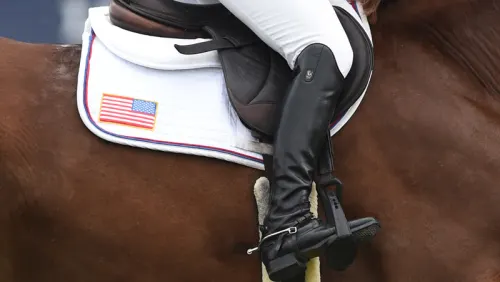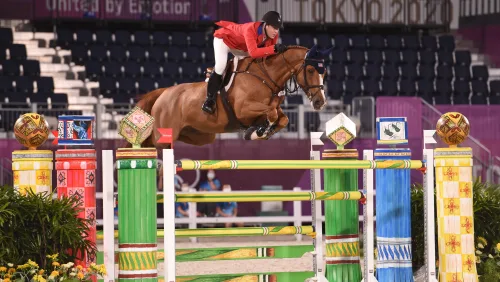In August 2021, Skylar Wireman didn’t know how she was going to transport her junior jumper home to California. He’d sustained a severe and mysterious injury while competing in Michigan, and she worried about how to safely move him. She never could’ve predicted that two years later Citoki would be back in the show ring and winning at the grand prix level.
When Citoki first walked through the Wiremans’ Chestnut Hills Equestrian Center in Bonsall, California, nine months earlier, trainer Shayne Wireman had concerns about whether he’d be the right partner for her daughter Skylar. “I was cautious at first because Skylar was recovering from her own injury at the time,” Shayne said. “Citoki would pin his ears in the stall, and he acted like he might get you. I quickly decided that it was more bark than bite. We just gave him lots of love, and Citoki quickly came around and stopped doing that. Now you would never even know it—he’s so sweet.”
The Holsteiner gelding (Catoki—Miyaki, Chambertin) had extensive European show jumping miles, and the Wiremans hoped he’d be the horse to help Skylar transition from the high juniors into the grand prix ranks. “I ride a lot of sales horses for my mom, but Citoki was the first real jumper that was mine,” Skylar said.
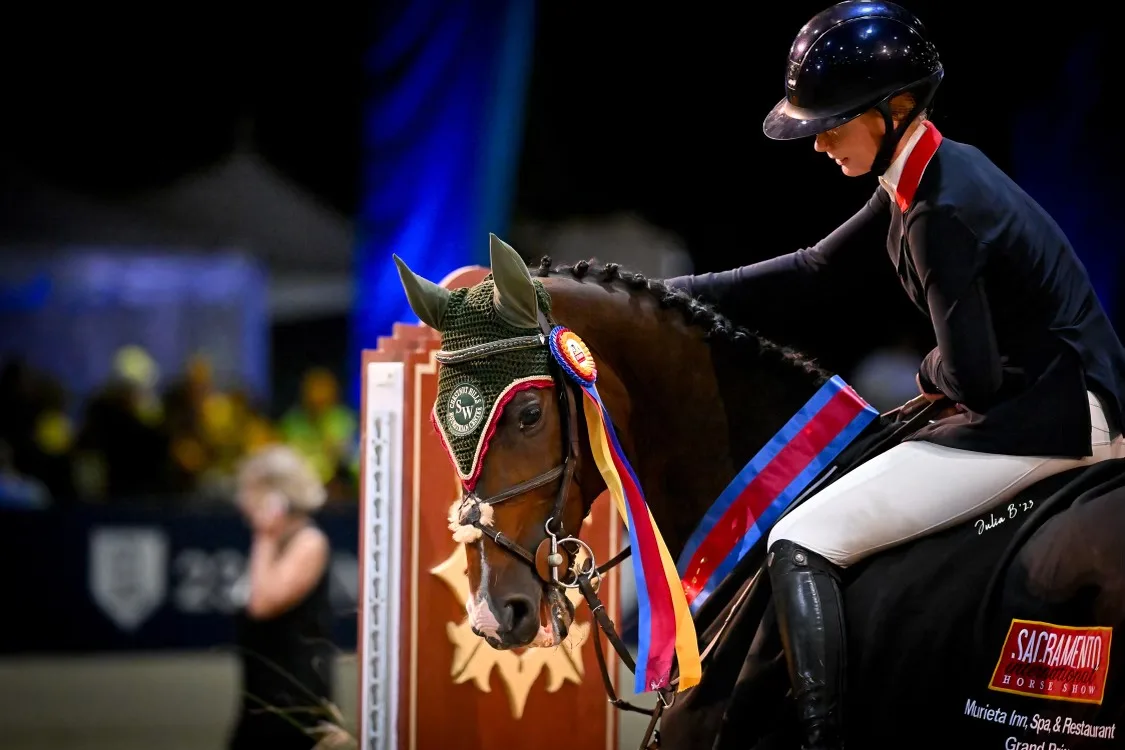
In 2021, Skylar qualified for the FEI North American Youth Championships, and Skylar and Shayne flew Citoki to Traverse City, Michigan, for the championship in August. The night before the warm-up class, a severe storm whipped through the showgrounds. “My mom and I were doing night check that night, and we got trapped in our barn—we were the only two people there at the time,” Skylar said. “There were tornado-type winds, the lights kept going on and off, and all of the horses were freaking out, spinning and screaming in their stalls.”
But by the next morning, the weather had calmed, and the footing had drained. “Citoki and I went into the training class, jumped the first two jumps, and headed toward the open water,” Skylar recalled. “We left the ground at the water, and he cleared it, but it felt terrible when we landed. It felt like a pogo hop. It was awful. I pulled up immediately.”
When Skylar watched the video, she saw that Citoki had landed on three legs. “When he landed, his left hind leg never touched the ground,” she said. “It was just up in the air cantering along as it would, but it wasn’t touching the ground at all.”
They called the show veterinarian, and over the next several days five additional veterinarians also examined Citoki. “None of them could find anything conclusive,” Skylar said. “We didn’t know what was wrong, but we knew it was bad. When he would walk, his whole left side and abdomen would spasm uncontrollably. The vets initially thought he had torn a muscle somewhere near his stifle or in his groin area.”
Their options for further diagnostics were to ship him 10 hours to Lexington, Kentucky, or wait several weeks for an appointment at Michigan State University. “It was a tricky situation,” Shayne said. “At the time of his injury, Citoki was so painful that trucking him so far to a clinic really wasn’t an option. With the help of the horse show vets, we had to help make him more comfortable before we could move him to a clinic.”
They gave Citoki non-steroidal anti-inflammatory drugs as well as using additional therapies such as cold lasers and a BEMER Horse-Set, which is a blanket that emits a low intensity pulsed electromagnetic field. The Wiremans appreciated the outpouring of support they received from other trainers and exhibitors during that stressful week. “So many of them would come over to our tent and check in with us daily, asking how Citoki was and if we needed anything,” Shayne said. “They offered their various therapies to help him—their BEMERs, cold lasers, etc. It was a strong sense of community. The circumstances were terrible, but the kindness showed the true caring that each of those professionals had.”
A few days after his injury, Citoki began bearing more weight on his left hind leg, and the Wiremans explored their options for safely transporting him home. “We called the San Luis Rey Equine Hospital, which is five minutes from our farm in California,” said Skylar. “They guaranteed they could see Citoki the next day.”
Shayne was nervous about sending Citoki with a commercial shipper when no one knew the extent of the gelding’s injuries. Then Mike Hebert, whom the Wiremans met at the NAYC, offered to ship Citoki home. “Mike had been helping us with cold lasering Citoki that week, and we became friends,” Shayne said. “I felt comfortable sending Citoki home with Mike; he would know if Citoki was beginning to struggle and if he needed to stop at a clinic along the way. I felt like Mike was invested in the outcome and really cared.”
ADVERTISEMENT
Citoki made the trip back to California safely, and Dr. Korin Potenza, DVM, CVA, took charge of his case. A bone scan revealed his pelvic region as a hot spot, but Potenza couldn’t pinpoint the injury’s location. She then used a rectal ultrasound, which showed her that Citoki’s pelvis was displaced. Potenza diagnosed Citoki with a fractured pelvis and recommended tying him in his stall for 30 days so he couldn’t lay down and injure himself further.
At the Wiremans’ farm, they moved Citoki into a 16×16 stall. They ran a heavy-duty steel cable diagonally across the stall, so Citoki could move freely while tied. “The main thing was the vets didn’t want Citoki to lay down,” Shayne explained. “If he tried to push himself up, he might re-fracture [his pelvis]. We attached a large chain link to the steel cable, put a carabiner on that, and then threaded his lead rope through the carabiner. The carabiner would slide as he would walk around the stall, and we could adjust the height of his head daily.”
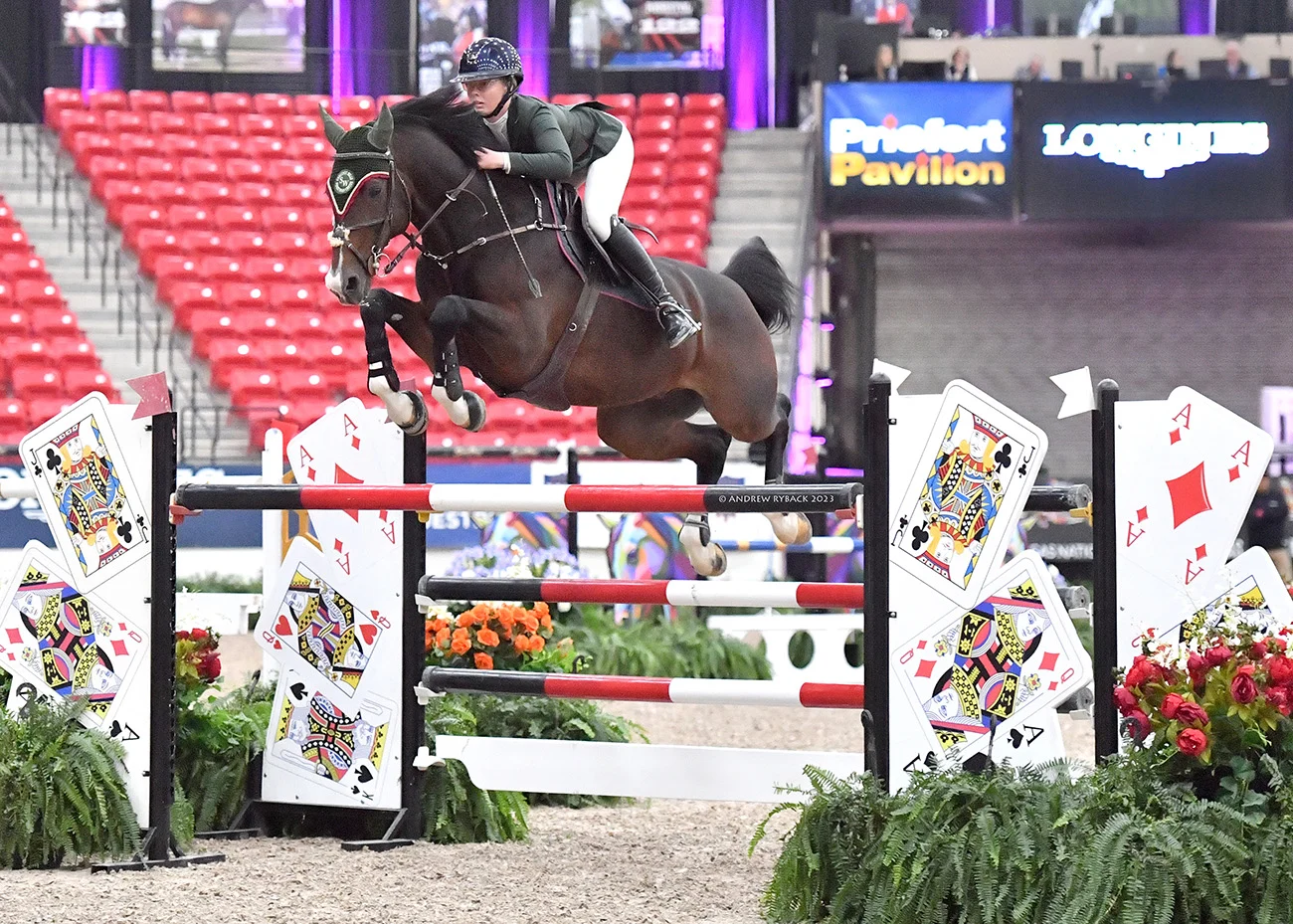
Citoki could move to reach his haynet and automatic waterer, but he was restricted from laying down. “He was so smart about the whole thing; he knew we were trying to help him,” Skylar said. “During that month, he figured out how to turn himself around while he was attached to the line, and he didn’t care at all about the noise from the carabiner gliding as he moved.”
Because Citoki was still favoring his left hind leg, veterinarians were also concerned about the possibility of founder. Skylar and Shayne took turns icing Citoki’s feet daily to minimize that risk. “We were also icing his hind end, which could get a little tricky because the ice would slide off occasionally,” she added. They continued to use the BEMER device but were able to stop giving him NSAIDs as he grew more comfortable.
After 30 days, the Wiremans brought Citoki back for another ultrasound. Potenza found three calcifications in three locations on the bones of his pelvis, which meant Citoki had likely fractured his pelvis in three separate places. “What the vets think happened is that the night of the storm [at NAYC], Citoki spun hard into his stall walls somehow, and then when he took off at the open water jump, he completed the fractures,” Skylar explained. “Now that we knew what was wrong, the vets could make recommendations going forward. They thought Citoki would be fine to return to flatting and maybe jumping small jumps, but they were unsure if he would ever jump grand prix or anything FEI again.”
Shayne was relieved to finally have a diagnosis. “Had I known that Citoki had pelvic fractures, I may have made another decision [about shipping him home to California],” she said. “But at the time, we only knew what we knew, and we did the best we could do for him.”
For the next three months, Citoki’s stall rest continued, although he was allowed to be loose in his stall. “We bedded like six or seven bags on one of the walls in his stall and made a ‘couch’ for him to lay against,” Skylar said. “That one side was elevated, so it made it easier for him to get up if he laid down.”
By January 2022, Citoki was cleared to begin tack walking. Skylar took her time with his rehab, focusing on strengthening the muscles in his hind end.
“We added the Thera-Band resistance band system with him too,” Skylar said. “When he started working again, he was short behind, and we weren’t sure how much he was physically going to be able to do. But then we realized that he was figuring out how to move again post-injury, and that it didn’t hurt; he needed to increase his muscle elasticity again. The more we kept going, the better he felt.”
Citoki returned to the show ring in July 2022 with Skylar at the Huntington Beach Sunshine Classic (California), where they won the low junior/amateur-owner jumper classic. “Sometimes he won’t go in the gate there, but he went right in this time,” Skylar said. “Citoki felt really good. He was phenomenal in his first class back and was really happy to be back at a show!”
They showed lightly the rest of the summer, and Skylar waited until November to enter a bigger competition, the CSI4*-W at the Las Vegas National. “Prior to Las Vegas, I had only jumped 1.20 meters with him, so I wasn’t sure what I was going to have at a bigger height,” Skylar said. “I figured it would be good to get him back in the ring and in the groove. He was jumping great all week!”
While they were in Las Vegas, another seemingly minor health issue popped up. Citoki’s right eye developed a tiny bluish ring. “We thought he may have scratched it at first, so we had the veterinarian out,” Shayne said. “It went away with some basic eye meds, and we didn’t think anything more of it.”
ADVERTISEMENT
But five months later, the blue tint returned. “His eye was half-blue in the morning, and then it got worse as the day went on,” Shayne said. “You could see the eyeball swelling a little bit, so we thought it was blunt-force trauma. But there was no swelling around the exterior of the eye or eye socket, and he couldn’t see out of the eye. We had our vet come out and stain the eye to make sure it wasn’t ulcerated.”

Their veterinarian gave them a neomycin, polymyxin B and dexamethasone ointment and recommended that Citoki see an equine ophthalmologist. Shayne found an ophthalmologist in Temecula, California, who suspected Citoki was experiencing glaucoma. “She told me he would likely lose the eye and be blind,” said Shayne. “That was not what I wanted to hear. We felt like we had to give it every effort to save the eye if we could.”
The ophthalmologist recommended an eye care routine that included four different eye medications administered three or four times per day. “When we started all the eye meds, Citoki was not a fan of ours!” Shayne said. She also repurposed a BEMER leg wrap to use on his eye after making sure it was safe to do so.
“Over the next few weeks, half of his eye cleared up,” said Shayne. “There was still a bubble over half of his eye where the blue was, but the other part looked normal. So we kept at it, and we got the eye to where there’s one small blue patch at the back of the eye. It’s not 100% clear, but he can mostly see out of it.”
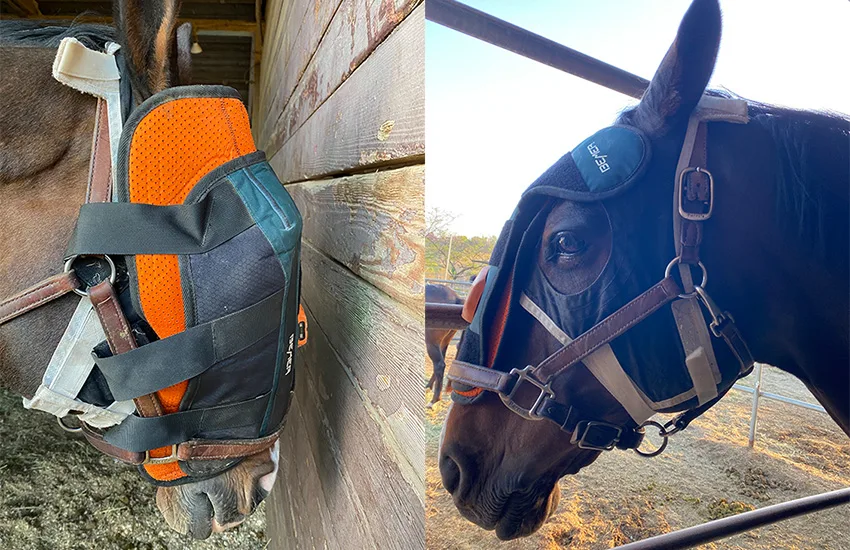
The ophthalmologist was pleased with Citoki’s progress on recheck but still guarded about the prognosis for his eye. “After that, we weaned him off all of the eye medications except for the [neomycin, polymyxin B and dexamethasone combination] and the sodium chloride ointment,” said Shayne. “He still gets those twice a day, and he has to come off of the poly neomycin when he shows FEI.”
When Skylar hacks and shows Citoki in USEF classes, she puts eQuick goggles on him to protect his right eye. “He still has a little blue spot toward the middle of the eye that never went away,” Skylar said. “But most of his eyesight is there, and that’s better than no eyesight.”

This past October, Skylar and Citoki won the $44,600 Murieta Inn & Spa 1.45-meter FEI Grand Prix during World Cup week at the 2023 Sacramento International (California). “Honestly, it didn’t feel real,” Wireman said. “That’s the biggest class I’ve won, and it’s his first FEI win. Citoki jumped so well in that class. I never knew if he would return to that level again. He feels better now than he ever did before. It takes a team to help with a horse that needs all of that done every day, but Citoki is special.”
During the Sacramento horse show, Shayne was on the East Coast with clients at the Capital Challenge Horse Show (Maryland). She stayed up late to watch her 19-year-old daughter compete on the livestream. “We jokingly call Skylar ‘the comeback kid’ all the time because she’s been in situations where you didn’t think she could overcome, and she did,” Shayne said. “It was a miracle to get Citoki jumping at all again—at 17 years old, to show at the FEI level with no meds is amazing. To have Citoki come back from two pretty scary things and be able to win a four-star class like that, it’s incredible.”
In November, the pair went on to win the $39,000 CSI4*-W 1.45-meter Double or Nothing Speed Stake at the Las Vegas National. Because Citoki will be 18 next year, Skylar plans to save him for special classes, like the World Cup qualifiers and FEI speed classes.
“When Citoki’s really in the game, he can be quite a competitive speed horse,” Skylar said. “He’s strong-willed, like me. When you set your mind to something, anything is possible.”
Do you know a horse or rider who returned to the competition ring after what should have been a life-threatening or career-ending injury or illness? Email Kimberly at kloushin@coth.com with their story.







